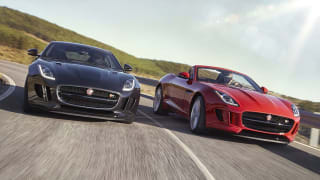
Jaguar F-Type 2015 review
If a real sports car needs a manual gearbox then the F‒Type Jaguar finally qualifies. The classic...
Browse over 9,000 car reviews
The 911 Turbo keeps evolving, topping the ranks of rapid road-goers without radical departures.
Porsche's whale-tailed 911 Turbo vied with the Lamborghini Countach for wall space in boys' bedrooms in the mid-1970s. Both supercars, they plied their trade in radically different ways.
Porsche pumped out the rear wheelarches of the 911 to fit larger rubber and a wider rear track and added a small table-sized rear tail to improve downforce. Both were necessary to cope with the power generated from the turbocharged 3.3-litre engine.
The Lambo used a V12 and radical, if impractical styling, including the trademark scissor doors and compromised rear vision, all now consigned to history.
On the other hand, the 911 Turbo evolved and has a deserved lineage as one of the quickest road-going cars on the planet.
The latest 911 Turbo is the fastest production car Porsche has produced and prices mirror the phenomenal performance.
The sprint to 100km/h is lowered by 0.2 sec to 3.0 seconds and Porsche is famously conservative with its claimed acceleration times
The standard car will cost $384,900 plus on-roads when it goes on sale in Australia in May (the current model costs $366,100).
The added outlay buys prodigious acceleration — the sprint to 100km/h is lowered by 0.2 sec to 3.0 seconds and Porsche is famously conservative with its claimed acceleration times — courtesy of a 14kW lift in power to 397kW.
Ante up $465,500 for the 427kW Turbo S (formerly $444,500) and take off another 0.1 sec on its way to a top speed of 330km/h. Cabrio versions will be $406,400 and $478,000 respectively.
Fuel consumption drops to 9.1L/100km for the coupes and 9.3L for the cabrios.
Straight-line performance is far from the Turbo's only party trick. It ultimately doesn't have the on-track precision of a 911 GT3 but compensates with more creature comforts, driving aids, the best dual-clutch transmission in the game and all-wheel drive power distribution that makes it a more reassuring ride on public roads.
In its latest guise the standard Chrono Sport pack is accessed from a mode dial on the new steering wheel with Normal, Sport, Sport Plus and Individual settings. A "sport response" button within the dial can be depressed to preset the engine and transmission for maximum acceleration, for 20 seconds at a time.
A dynamic boost function now limits turbocharger lag, thereby improving throttle response. The software cuts fuel injection when the driver backs off but keeps the throttle valve open, which Porsche says leads to improved response when the driver gets back on the gas.
There's also a new mode for the stability control setting to let the back end slide more before the software reins things back in.
Porsche product head August Achleitner says it is "not the fastest mode on the track but it is the most spectacular one".
75-80 per cent of Porsche owners use iPhones, so there's no rush to introduce Android Auto
Active suspension, which adjusts the damper stiffness depending on the mode and how the car is being driven, is standard, as is a reversing camera, which was previously on the options list.
The Turbo S adds a chassis anti-roll setup to keep the car flat when cornering and carbon ceramic brakes to avoid fade during track days. Additional cabin bling includes carbon-fibre and upholstery is two-tone leather.
Subtle styling tweaks amount to a pair of LED indicators on the front bumper to emphasise its width, reshaped front cooling ducts and a revised spoiler.
The tail-lights are redesigned and the engine cover now has vertical louvres on each side and a separate central scoop, which Porsche says maximises air flow to the twin-turbo 3.8-litre engine.
Interior enhancements include a touchscreen with sharper resolution touchscreen and connectivity upgrades, including Wi-Fi pairing with smart devices and Apple CarPlay.
Achleitner says research shows 75-80 per cent of Porsche owners use iPhones, so there's no rush to introduce Android Auto.
Options include lane-change monitoring and, replacing the 12-speaker Bose audio, a 19-speaker Burmester setup. A lift function raises the front spoiler by up to 40mm to improve ground clearance at low speeds.
The 911 Turbo remains a compelling proposition. This update doesn't involve radical changes and there's not much call to do so when you've been at the top of the supercar rankings for more than 40 years. The legend continues.
Click here for more 2016 Porsche 911 Turbo (convertible) price and spec info
Click here for more 2016 Porsche 911 Turbo (coupe) price and spec info
| Vehicle | Specs | Price* | |
|---|---|---|---|
| GT3 | 3.8L, PULP, 7 SP AUTO | No recent listings | 2016 Porsche 911 2016 GT3 Pricing and Specs |
| GT3 RS | 4.0L, PULP, 7 SP AUTO | No recent listings | 2016 Porsche 911 2016 GT3 RS Pricing and Specs |
| Targa 4 | 3.4L, PULP, 7 SP AUTO | $109,340 – 125,730 | 2016 Porsche 911 2016 Targa 4 Pricing and Specs |
| Targa 4 GTS | 3.8L, PULP, 7 SP AUTO | $160,160 – 184,030 | 2016 Porsche 911 2016 Targa 4 GTS Pricing and Specs |
$189,990
Lowest price, based on 3 car listings in the last 6 months